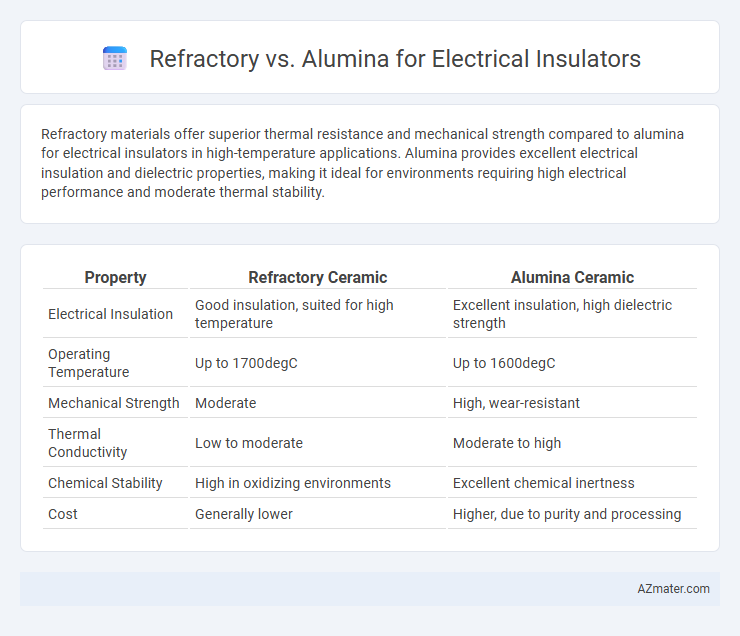Refractory materials offer superior thermal resistance and mechanical strength compared to alumina for electrical insulators in high-temperature applications. Alumina provides excellent electrical insulation and dielectric properties, making it ideal for environments requiring high electrical performance and moderate thermal stability.
Table of Comparison
| Property | Refractory Ceramic | Alumina Ceramic |
|---|---|---|
| Electrical Insulation | Good insulation, suited for high temperature | Excellent insulation, high dielectric strength |
| Operating Temperature | Up to 1700degC | Up to 1600degC |
| Mechanical Strength | Moderate | High, wear-resistant |
| Thermal Conductivity | Low to moderate | Moderate to high |
| Chemical Stability | High in oxidizing environments | Excellent chemical inertness |
| Cost | Generally lower | Higher, due to purity and processing |
Understanding Electrical Insulators: The Basics
Refractory materials and alumina both serve as electrical insulators due to their high resistivity and thermal stability, with alumina offering superior dielectric strength and corrosion resistance. Refractory insulators are typically composed of materials like silica or magnesia, providing excellent heat resistance but lower electrical insulation compared to alumina's high-purity alumina oxide structure. Understanding these differences is crucial for selecting materials that maintain electrical insulation under extreme thermal and mechanical stress in industrial applications.
What Are Refractories? Key Properties and Types
Refractories are heat-resistant materials essential for insulating and protecting electrical equipment from high temperatures. Key properties include high melting point, thermal stability, mechanical strength, and resistance to chemical corrosion. Common types encompass fireclay, silica, alumina, and magnesia, with alumina refractory offering superior electrical insulation and thermal conductivity compared to basic refractories.
Alumina: Composition and Characteristics
Alumina, a ceramic material composed primarily of aluminum oxide (Al2O3), exhibits exceptional electrical insulation properties characterized by high dielectric strength and low electrical conductivity. Its crystalline structure provides excellent thermal stability, chemical inertness, and mechanical strength, making it ideal for high-voltage insulators and harsh environments. The purity and grain size of alumina significantly influence its insulating performance, with high-purity alumina (>99%) offering superior resistance to electrical breakdown and thermal shock compared to standard refractory materials.
Comparing Mechanical Strength: Refractory vs Alumina
Alumina exhibits superior mechanical strength compared to most refractory materials, making it a preferred choice for electrical insulators subjected to high mechanical stress. Refractory materials often have lower fracture toughness and tensile strength, limiting their use in applications where durability and resistance to mechanical deformation are critical. Alumina's high hardness and robust structural integrity enhance its reliability and longevity in electrical insulation under demanding conditions.
Thermal Stability in Electrical Applications
Refractory materials exhibit exceptional thermal stability in electrical insulators, enduring temperatures up to 1800degC without significant degradation, making them suitable for high-temperature electrical environments. Alumina insulators, with thermal stability up to 1600degC and excellent dielectric strength, provide superior performance in moderate high-temperature applications while maintaining electrical insulation properties. The choice between refractory and alumina insulators depends on specific thermal operating ranges and electrical insulation requirements in devices such as transformers, capacitors, and high-temperature sensors.
Electrical Insulation Performance: A Material Perspective
Refractory materials typically exhibit moderate electrical insulation properties with high thermal resistance, making them suitable for applications requiring simultaneous heat and electrical insulation. Alumina, a ceramic with excellent dielectric strength and low electrical conductivity, offers superior electrical insulation performance, particularly in high-voltage and high-temperature environments. Its chemical stability and mechanical robustness further enhance its effectiveness as an electrical insulator compared to traditional refractory options.
Durability and Lifespan: Which Material Lasts Longer?
Alumina exhibits superior durability and a longer lifespan compared to refractory materials in electrical insulation due to its high resistance to thermal shock, corrosion, and electrical conductivity degradation. Refractory materials, often composed of silica or fireclay, tend to degrade faster under prolonged high-temperature exposure and mechanical stress. The dense crystalline structure of alumina ensures enhanced stability and performance in demanding electrical applications, making it the preferred choice for long-term insulation solutions.
Cost Analysis: Refractory vs Alumina Insulators
Refractory insulators typically offer lower initial costs compared to alumina insulators due to cheaper raw materials and simpler manufacturing processes. Alumina insulators, while more expensive upfront, provide superior electrical insulation properties and higher durability, reducing maintenance and replacement expenses over time. Cost analysis reveals that the long-term value of alumina often outweighs the short-term savings of refractory, especially in high-performance or demanding electrical applications.
Industry Applications and Suitability
Refractory materials and alumina serve distinct roles in electrical insulation, with refractory materials excelling in high-temperature industrial applications such as furnace linings and kilns due to their thermal stability and resistance to thermal shock. Alumina, known for its superior electrical resistance, mechanical strength, and chemical inertness, is widely used in electronic devices, insulators for high-voltage equipment, and semiconductor manufacturing. The choice between refractory and alumina depends heavily on operating temperature, mechanical stresses, and electrical insulation requirements, making alumina preferable in high-purity electrical environments while refractory materials are favored for robust, heat-intensive industrial settings.
Selecting the Right Material for Electrical Insulators
Selecting the right material for electrical insulators requires understanding the distinct properties of refractory and alumina ceramics. Alumina offers excellent electrical insulation, high dielectric strength, and superior thermal stability, making it ideal for high-voltage applications. Refractory materials provide exceptional resistance to thermal shock and chemical corrosion but typically have lower electrical insulation properties compared to alumina.

Infographic: Refractory vs Alumina for Electrical insulator
 azmater.com
azmater.com